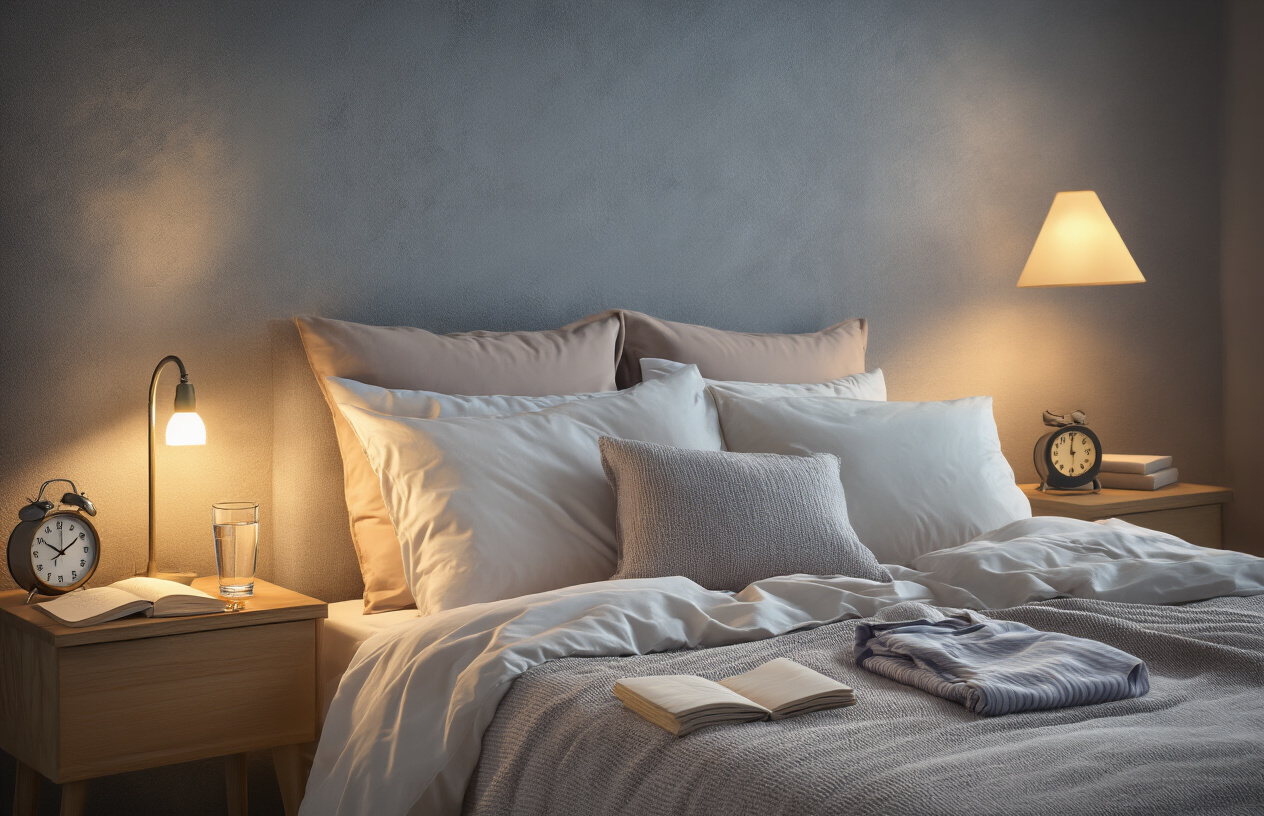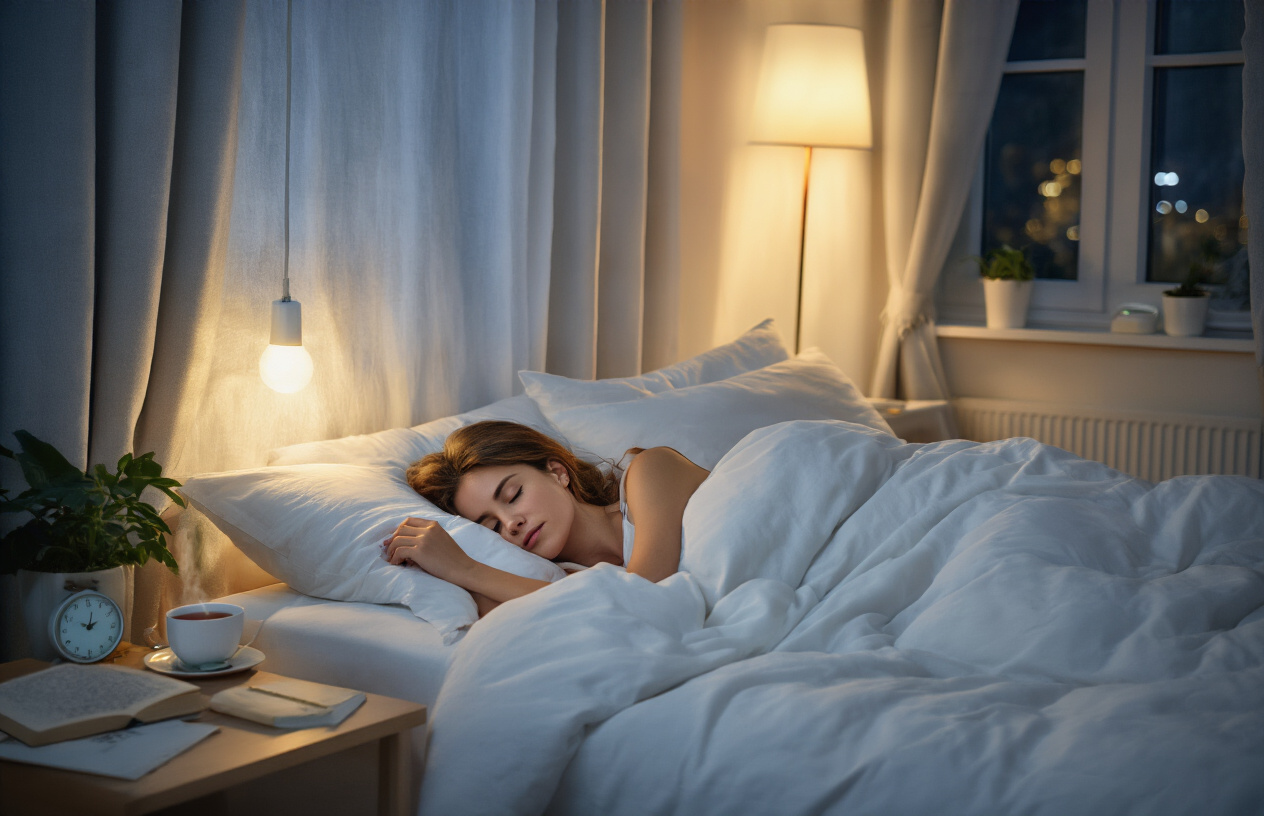The Ultimate Guide to Falling Asleep Fast
Tossing and turning for hours when you just want to sleep? You’re not alone. Millions of people struggle to fall asleep quickly, leaving them exhausted and frustrated the next day.
This guide is for anyone who wants to learn how to fall asleep fast—busy professionals burning the candle at both ends, parents juggling endless responsibilities, students stressed about deadlines, or anyone whose mind won’t quiet down at bedtime.
We’ll walk through proven methods to create the perfect sleep environment that signals your brain it’s time to rest. You’ll discover powerful relaxation techniques like the 4-7-8 breathing method that can knock you out in minutes. Plus, we’ll cover how to handle those racing thoughts that keep you staring at the ceiling when you should be dreaming.
Ready to transform your nights from restless to restful? Let’s dive in.
Create the Perfect Sleep Environment

Optimize your bedroom temperature for faster sleep onset
Your body naturally drops its core temperature as you prepare for sleep, signaling your brain that it’s time to rest. The ideal bedroom temperature sits between 60-67°F (15-19°C), with most sleep experts recommending around 65°F (18°C) as the sweet spot.
When your room is too warm, your body struggles to initiate this temperature drop, leaving you tossing and turning. Hot environments also increase restlessness and reduce deep sleep stages. On the flip side, a room that’s too cold can cause muscle tension and frequent wake-ups.
Consider these temperature optimization strategies:
- Use a programmable thermostat to automatically lower the temperature 1-2 hours before bedtime
- Try cooling mattress toppers or pillows filled with gel or breathable materials
- Take a warm bath or shower 60-90 minutes before bed to accelerate your body’s natural cooling process
- Wear lightweight, breathable sleepwear made from natural fibers like cotton or bamboo
Block out light and noise for uninterrupted rest
Light exposure directly impacts your circadian rhythm by suppressing melatonin production. Even small amounts of light from streetlamps, electronics, or early morning sun can fragment your sleep and reduce sleep quality.
Light-blocking solutions:
- Blackout curtains or blinds that completely seal windows
- Eye masks for travel or when blackout curtains aren’t enough
- Cover or remove LED lights from electronics, alarm clocks, and charging devices
- Use dim, warm lighting in the hours leading up to bedtime
Noise management techniques:
- White noise machines or apps that mask disruptive sounds
- Earplugs designed specifically for sleeping comfort
- Soft background sounds like rain, ocean waves, or gentle instrumental music
- Address noise sources by weatherstripping doors, adding rugs, or using draft stoppers
Choose the right mattress and pillow for comfort
Your sleep surface plays a crucial role in how quickly you fall asleep and stay asleep throughout the night. An uncomfortable mattress or pillow creates pressure points, causes tossing and turning, and can lead to morning aches that disrupt your sleep cycle.
Mattress selection criteria:
- Firmness level should match your sleep position and body weight
- Material type (memory foam, latex, innerspring, or hybrid) based on your temperature preferences and support needs
- Age of mattress – replace every 7-10 years as materials break down and lose support
| Sleep Position | Recommended Firmness | Pillow Height |
|---|---|---|
| Side sleeper | Medium to medium-soft | High (fills neck gap) |
| Back sleeper | Medium to medium-firm | Medium (supports natural curve) |
| Stomach sleeper | Firm | Low (prevents neck strain) |
Pillow considerations:
Your pillow should keep your spine aligned and support your neck’s natural curve. Side sleepers need higher pillows to fill the gap between their shoulder and head, while stomach sleepers need thin pillows to prevent neck hyperextension.
Remove electronic distractions from your sleep space
Electronic devices emit blue light that tricks your brain into thinking it’s daytime, suppressing melatonin production and making it harder to fall asleep. Beyond the light exposure, the mental stimulation from checking messages, scrolling social media, or watching videos keeps your mind active when it should be winding down.
Create an electronics-free bedroom:
- Charge devices outside the bedroom to eliminate temptation and reduce EMF exposure
- Use a traditional alarm clock instead of your phone
- Remove televisions from the sleep space entirely
- Install apps that filter blue light if you must use devices before bed
- Establish a “digital sunset” by turning off screens 1-2 hours before bedtime
Replace evening screen time with relaxing activities like reading a physical book, gentle stretching, journaling, or practicing meditation. This mental shift helps signal to your brain that sleep time is approaching and makes falling asleep much easier.
Master Pre-Sleep Relaxation Techniques

Practice Deep Breathing Exercises to Calm Your Mind
When your mind is racing with thoughts from the day, controlled breathing acts like a reset button for your nervous system. The beauty of breathing exercises lies in their simplicity – you can do them anywhere, anytime, without any special equipment.
Start with basic diaphragmatic breathing, also known as belly breathing. Place one hand on your chest and another on your stomach. Breathe in slowly through your nose for four counts, making sure the hand on your stomach rises while the one on your chest stays relatively still. Hold for two counts, then exhale through your mouth for six counts. This activates your parasympathetic nervous system, which signals your body that it’s time to wind down.
The box breathing technique works exceptionally well for sleep preparation. Inhale for four counts, hold for four, exhale for four, and hold empty for four. Repeat this cycle 8-10 times. Military personnel and first responders use this method to manage stress and find calm quickly.
For an even more powerful effect, try the 4-7-8 method before bed. Exhale completely, then inhale through your nose for four counts, hold your breath for seven counts, and exhale through your mouth for eight counts. This technique naturally slows your heart rate and creates a meditative state that primes your body for sleep.
Use Progressive Muscle Relaxation to Release Tension
Your body holds stress in ways you might not even realize. Progressive muscle relaxation systematically releases this physical tension, creating a domino effect of calm throughout your entire system.
Begin at your toes and work your way up. Tense each muscle group for five seconds, then release and notice the contrast between tension and relaxation. Curl your toes tightly, hold, then let them go completely loose. Move to your calves – flex them hard, hold, then release. Continue with your thighs, glutes, abdomen, hands, arms, shoulders, and face.
Pay special attention to areas where you typically hold stress. Most people carry tension in their shoulders, jaw, and forehead without realizing it. When you reach your face, scrunch everything together – close your eyes tightly, furrow your brow, clench your jaw – then let it all melt away.
The key is the contrast. When you deliberately create tension and then release it, your muscles relax more deeply than they would naturally. This sends a clear message to your brain that it’s safe to let go and prepare for rest.
Some people find it helpful to imagine the tension flowing out of their body like water draining from a bathtub. Others prefer to think of each muscle group becoming heavy and sinking into the mattress. Find the mental imagery that works best for you.
Try Meditation and Mindfulness for Mental Stillness
Meditation doesn’t require you to empty your mind completely – that’s actually impossible and not the goal. Instead, it’s about observing your thoughts without getting caught up in them, like watching clouds pass by in the sky.
Body scan meditation works particularly well for sleep. Starting from the top of your head, slowly move your attention down through every part of your body. Notice any sensations without trying to change them. Is your forehead tight? Are your shoulders raised? Simply acknowledge what you find and gently encourage those areas to soften.
Mindfulness meditation focuses on present-moment awareness. Choose an anchor – your breath, the feeling of your body against the mattress, or even ambient sounds. When your mind wanders to tomorrow’s meeting or yesterday’s conversation, gently guide your attention back to your chosen anchor without judgment.
Guided sleep meditations can be incredibly helpful, especially when you’re starting out. Apps and recordings provide a soothing voice to follow, taking the guesswork out of the process. Look for ones specifically designed for sleep that last 10-20 minutes.
Loving-kindness meditation offers another approach. Send good wishes to yourself, loved ones, acquaintances, and even difficult people in your life. This practice shifts your mental state from worry or frustration to compassion and peace, creating ideal conditions for sleep.
The goal isn’t perfect meditation – it’s consistency. Even five minutes of mindful breathing can make a significant difference in how quickly you fall asleep and the quality of your rest.
Establish a Consistent Bedtime Routine

Set a fixed sleep schedule and stick to it
Your body craves consistency more than you might realize. Going to bed and waking up at the same time every day—yes, even on weekends—helps regulate your circadian rhythm, your internal biological clock that controls sleep-wake cycles. When you maintain regular sleep and wake times, your brain begins to anticipate these patterns and naturally prepares your body for sleep as bedtime approaches.
Start by choosing a bedtime that allows for 7-9 hours of sleep before your desired wake time. If you currently go to bed at wildly different times, don’t try to shift your schedule dramatically overnight. Instead, adjust your bedtime by 15-30 minutes earlier each night until you reach your target time. This gradual approach prevents the shock to your system that can make the transition more difficult.
Weekend sleep-ins might feel tempting, but they can throw off your entire week’s progress. Social jet lag—the phenomenon of shifting your sleep schedule on weekends—can leave you feeling groggy and disoriented come Monday morning. If you absolutely must sleep in, limit it to no more than one hour past your usual wake time.
Create calming pre-sleep rituals that signal bedtime
Your brain needs clear signals that it’s time to wind down. Creating consistent pre-sleep rituals acts like a dimmer switch for your nervous system, gradually shifting you from daytime alertness to nighttime relaxation. These rituals work because they create psychological associations between specific activities and sleep preparation.
Consider incorporating these calming activities into your nightly routine:
- Gentle stretching or yoga – Light movement helps release physical tension accumulated throughout the day
- Reading a book – Choose fiction or something non-stimulating to avoid activating your analytical mind
- Listening to soft music or nature sounds – Slow-tempo music (60-80 beats per minute) can synchronize with your heart rate as it naturally slows
- Journaling – Writing down thoughts helps clear mental clutter and worries from your mind
- Taking a warm bath or shower – The drop in body temperature afterward mimics your natural pre-sleep cooling process
The key is consistency. Pick 2-3 activities that feel natural and enjoyable, then perform them in the same order each night. Your brain will learn to associate these activities with sleep, making the transition to drowsiness more automatic.
Wind down with relaxing activities 30 minutes before bed
The hour before bedtime is crucial for sleep preparation. During this window, your body temperature naturally begins to drop, melatonin production increases, and your nervous system starts shifting toward rest mode. Supporting these natural processes with intentional winding-down activities can dramatically improve how quickly you fall asleep.
Create a buffer zone between your active day and sleep time. This isn’t just about avoiding screens—though that’s important. It’s about consciously choosing activities that promote relaxation rather than stimulation. Progressive muscle relaxation, where you tense and release different muscle groups, can be particularly effective during this time.
Consider dimming the lights throughout your home during this wind-down period. Bright lights suppress melatonin production, so creating a gradually darkening environment helps signal to your brain that sleep time is approaching. Use lamps instead of overhead lighting, and consider warm-toned bulbs that emit less blue light.
Avoid stimulating activities in the evening hours
What you do in the hours leading up to bedtime can either support or sabotage your sleep efforts. Stimulating activities activate your sympathetic nervous system, flooding your body with alertness hormones that can take hours to subside. Understanding which activities to avoid—and when—can make the difference between tossing and turning or drifting off peacefully.
Activities to avoid 2-3 hours before bedtime:
| Activity | Why It Disrupts Sleep | Better Alternative |
|---|---|---|
| Intense exercise | Raises core body temperature and releases energizing hormones | Light stretching or yoga |
| Work-related tasks | Activates analytical thinking and stress response | Set a “work cutoff” time |
| Heated discussions or arguments | Elevates stress hormones and emotional arousal | Save difficult conversations for daytime |
| Thrilling movies or books | Increases heart rate and mental stimulation | Choose calmer, slower-paced content |
| Large meals | Diverts energy to digestion and can cause discomfort | Finish eating 3 hours before bed |
Electronic devices deserve special mention. The blue light emitted by phones, tablets, computers, and televisions suppresses melatonin production for up to three hours after exposure. If you must use devices in the evening, use blue light filters or wear blue light blocking glasses at least two hours before bedtime.
Remember that caffeine can stay in your system for 6-8 hours, so that afternoon coffee might still be affecting you at bedtime. Similarly, while alcohol might make you feel drowsy initially, it disrupts sleep quality later in the night, leading to frequent awakenings and less restorative sleep.
Use the 4-7-8 Breathing Method and Other Quick Techniques

Learn the 4-7-8 breathing technique for instant relaxation
The 4-7-8 breathing method is a powerful tool that can help you fall asleep in just 60 seconds. Developed by Dr. Andrew Weil, this technique works by activating your parasympathetic nervous system, which signals your body to relax and prepare for sleep.
Here’s how to do it:
- Position yourself comfortably – Lie down or sit with your back straight
- Exhale completely through your mouth, making a whoosh sound
- Inhale through your nose for 4 counts while keeping your mouth closed
- Hold your breath for 7 counts
- Exhale through your mouth for 8 counts, making that whoosh sound again
- Repeat the cycle 3-4 times when starting out
The magic happens because this breathing pattern forces your heart rate to slow down and increases oxygen levels in your bloodstream. When you hold your breath, you’re building up carbon dioxide, and when you exhale slowly, you’re releasing tension throughout your entire body.
Start with just a few cycles and gradually work up to eight complete rounds. Some people feel lightheaded at first, which is completely normal. If this happens, reduce the number of cycles until your body adapts to the technique.
Try the body scan method to release physical tension
Your body holds stress in ways you might not even realize. Tight shoulders, clenched jaw, tensed calves – all of this physical tension can keep your mind alert when you’re trying to sleep. The body scan method systematically releases this tension from head to toe.
Progressive muscle relaxation steps:
- Start at your toes – Clench them tightly for 5 seconds, then release and notice the contrast
- Move to your calves – Tense and release, feeling the muscles soften
- Continue upward – Work through your thighs, glutes, abdomen, hands, arms, shoulders, neck, and face
- Hold each tension for about 5 seconds before releasing
- Focus on the contrast between tension and relaxation
As you progress through each muscle group, you’ll likely discover areas where you’re unconsciously holding stress. Your jaw might be clenched, your shoulders raised, or your hands formed into fists. This awareness alone often provides immediate relief.
The body scan doesn’t just release physical tension – it also gives your racing mind something specific to focus on. Instead of worrying about tomorrow’s meeting or replaying today’s conversations, you’re directing your attention to physical sensations in the present moment.
Practice visualization techniques for mental escape
Visualization transforms your bedroom into a mental sanctuary. When your mind is busy creating peaceful imagery, it can’t simultaneously worry about stress or tomorrow’s responsibilities. Think of it as giving your brain a different channel to tune into.
Effective visualization scenarios:
| Scenario | Key Elements | Why It Works |
|---|---|---|
| Beach setting | Warm sand, gentle waves, ocean breeze | Natural rhythms are inherently calming |
| Mountain cabin | Crackling fire, soft blankets, snow falling | Creates feelings of safety and warmth |
| Floating in space | Weightlessness, distant stars, silence | Removes all earthly concerns and tensions |
| Childhood bedroom | Familiar comfort, safety, peace | Taps into deep feelings of security |
The key is engaging multiple senses in your visualization. Don’t just see the beach – feel the warm sand between your toes, hear the rhythmic waves, smell the salt air, and taste the ocean breeze. The more vivid and detailed your mental imagery, the more effectively it will transport your mind away from daily stresses.
Some people prefer guided visualizations using apps or recordings, while others create their own mental movies. Experiment with both approaches to see what works best for you. The goal is finding imagery that feels personally meaningful and naturally relaxing.
Remember, these techniques work best when practiced regularly, not just when you’re desperately trying to fall asleep. Spend a few minutes each day practicing these methods so they become second nature when you need them most.
Optimize Your Diet and Timing for Better Sleep

Avoid caffeine and alcohol before bedtime
Caffeine can stay in your system for up to 8 hours, making that afternoon coffee a potential sleep saboteur. Stop consuming caffeine after 2 PM to give your body enough time to process it before bedtime. This includes coffee, tea, chocolate, energy drinks, and even some medications. Dark chocolate contains enough caffeine to interfere with sleep if eaten close to bedtime.
Alcohol might make you feel drowsy initially, but it disrupts your sleep cycles later in the night. While it can help you fall asleep faster, alcohol reduces REM sleep quality and causes frequent wake-ups. Your body metabolizes alcohol at about one drink per hour, so plan accordingly if you choose to drink earlier in the evening.
Choose sleep-promoting foods and beverages
Certain foods naturally support better sleep by boosting melatonin production or providing calming nutrients. Tart cherries contain natural melatonin and can significantly improve sleep quality. A small glass of tart cherry juice 1-2 hours before bed works best.
Foods rich in tryptophan help your body produce serotonin and melatonin. Turkey, milk, eggs, cheese, salmon, and pumpkin seeds are excellent sources. Combine tryptophan-rich foods with complex carbohydrates like whole grain crackers or oatmeal to enhance absorption.
| Sleep-Promoting Foods | Key Nutrients | Best Timing |
|---|---|---|
| Tart cherries | Natural melatonin | 1-2 hours before bed |
| Almonds | Magnesium, protein | Evening snack |
| Kiwi fruit | Serotonin precursors | 1 hour before bed |
| Chamomile tea | Apigenin | 30-60 minutes before bed |
| Fatty fish | Omega-3, vitamin D | Dinner |
Time your last meal for optimal digestion
Eating large meals close to bedtime forces your digestive system to work when it should be winding down. Finish your last substantial meal 3-4 hours before sleep to allow proper digestion. This prevents acid reflux, bloating, and the uncomfortable feeling of food sitting in your stomach.
If you get hungry before bed, stick to light snacks under 200 calories. A small banana with almond butter, Greek yogurt with berries, or whole grain crackers with cheese work well. These combinations provide protein and complex carbohydrates without overwhelming your system.
Avoid spicy, fatty, or acidic foods in the evening as they can cause heartburn and indigestion that interfere with sleep. Your body temperature naturally drops as bedtime approaches, and digesting heavy meals raises your core temperature, working against this natural process.
Stay hydrated without disrupting sleep
Proper hydration supports overall sleep quality, but timing matters. Drink most of your daily water intake earlier in the day and taper off 2-3 hours before bedtime to minimize nighttime bathroom trips.
If you’re thirsty before bed, take small sips rather than drinking a full glass. Room temperature water is easier on your system than ice-cold water, which can be stimulating. Keep a small glass of water by your bed for quick sips if needed during the night.
Monitor your urine color during the day – pale yellow indicates good hydration. Dark yellow suggests you need more fluids earlier in the day, not right before sleep.
Consider natural sleep aids and supplements
Several natural supplements can support healthy sleep patterns when used appropriately. Melatonin works best for adjusting your sleep schedule rather than as a nightly sleep aid. Start with the lowest effective dose (0.5-1mg) taken 30 minutes before your desired bedtime.
Magnesium helps relax muscles and calm the nervous system. Magnesium glycinate is gentle on the stomach and well-absorbed. Take 200-400mg about an hour before bed. L-theanine, found in tea, promotes relaxation without drowsiness and pairs well with magnesium.
Valerian root and passionflower are traditional herbs that some people find helpful, though effects vary. Always consult a healthcare provider before starting new supplements, especially if you take medications or have health conditions. Natural doesn’t always mean safe for everyone, and some supplements can interact with prescription drugs.
Handle Racing Thoughts and Sleep Anxiety

Write Down Worries to Clear Your Mind
Your brain treats unfinished tasks and unresolved worries like open browser tabs – they keep running in the background, consuming mental energy even when you’re trying to sleep. Writing down your concerns creates a psychological release valve that signals to your mind it’s safe to rest.
Keep a notebook and pen beside your bed specifically for this purpose. When thoughts start spiraling, grab your worry journal and dump everything onto paper. Don’t worry about grammar, organization, or solutions – just get the thoughts out of your head and onto the page. This simple act of externalization tells your brain that the worries are captured and won’t be forgotten, allowing it to finally power down.
The key is writing by hand rather than typing. The physical act of putting pen to paper creates a stronger neural connection and helps your brain process the transition from active worry to passive storage. Some people find it helpful to end each worry session by writing “I’ll deal with this tomorrow” at the bottom of the page.
Use the “Worry Time” Technique to Manage Anxious Thoughts
Designate a specific 15-20 minute window earlier in your day as your official “worry time.” This structured approach prevents anxious thoughts from hijacking your sleep hours by giving them a scheduled outlet.
During worry time, sit down with your journal and actively engage with your concerns. Ask yourself:
- Is this worry realistic or am I catastrophizing?
- What specific actions can I take to address this?
- What parts of this situation are within my control?
When bedtime worries surface, remind yourself: “I already handled my worries today. If this is important, I’ll add it to tomorrow’s worry time.” This mental boundary helps train your brain to respect the separation between problem-solving hours and rest hours.
Schedule your worry time at least 2-3 hours before bedtime to avoid stirring up anxiety too close to sleep. Many people find mid-afternoon works well, as it catches worries before they build momentum but leaves enough time for the mental agitation to settle.
Practice Acceptance When Sleep Doesn’t Come Immediately
Fighting sleeplessness creates a vicious cycle where anxiety about not sleeping becomes the very thing keeping you awake. The harder you try to force sleep, the more elusive it becomes. Learning to accept wakefulness paradoxically helps you fall asleep faster.
When you notice you’ve been lying awake for more than 20 minutes, avoid checking the clock repeatedly or calculating how many hours of sleep you’ll get. Instead, shift your focus from “I must fall asleep now” to “I’m giving my body time to rest, even if I’m not sleeping.”
Use this wakeful time productively by practicing gentle breathing exercises or progressive muscle relaxation. Tell yourself: “Even lying here quietly is restorative. My body is still benefiting from this rest time.” This mindset removes the pressure and often allows natural drowsiness to return.
If acceptance feels difficult, try the “so what?” technique. Ask yourself what’s the worst thing that could happen if you don’t sleep perfectly tonight. Usually, you’ll realize you’ve managed on less sleep before and can do it again. This perspective shift reduces the stakes and takes pressure off your need to sleep immediately.

Getting better sleep doesn’t have to be complicated. The strategies we’ve covered—from creating a cool, dark bedroom to practicing the 4-7-8 breathing technique—are simple changes that can make a real difference. Your sleep environment, bedtime routine, and what you eat all play important roles in how quickly you drift off. When your mind starts racing at bedtime, having relaxation techniques ready can help you regain control.
Start with one or two changes that feel most doable for you right now. Maybe that’s setting a consistent bedtime or trying deep breathing exercises. Once those become habits, you can gradually add other techniques. Good sleep is an investment in your health, mood, and energy levels. Give these methods a few weeks to work their magic—your body and mind will thank you for it.













